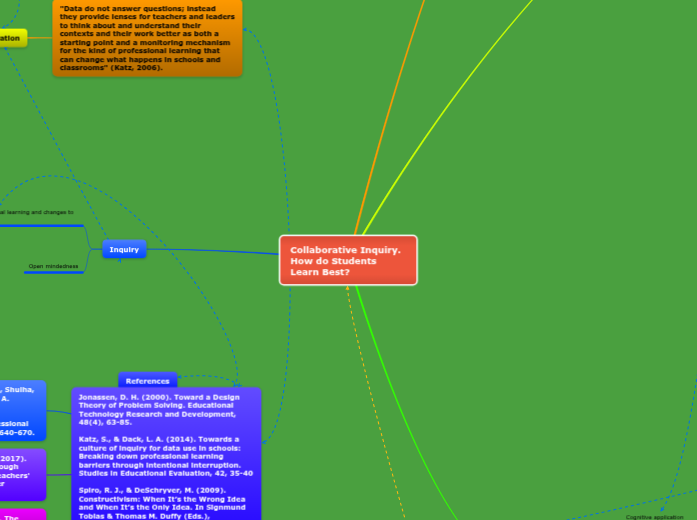Collaborative Inquiry. How do Students Learn Best?
Burning Questions
How can we utilize collaborative tools to improve our cross departmental collaboration/communication in order to provide our students a more authentic and effective cross-departmental experience?
What technology might serve to help collaborators communicate without consuming large amounts of time?
Google Drive?
How do institutional structures and administration initiatives work to inhibit or encourage collaboration within education?
“In the literature, there is significant research to identify a clear correlation between successful CI and leadership training (David2009, Ermeling2010, Givenet al.2010, Galligan2011, von Gnetchen2011). In his research on tracing the effects of inquiry on classroom practice, Ermeling specifically noted that: Having a trained leader dedicated to the work of guiding the process, moderating discussion, probing for deeper understanding, and providing a balance of support and pressure, helped create a safe and productive environment where participants could focus on the work of improving instruction. (Emeling2010, p. 386)As schools begin to engage in developing a culture of CI, they will probably have to re-examine their understanding of leadership within their school culture” (Deluca et.al 2017).
This concept is huge, I think. The leader must be a part of the learning process and be willing to challenge their own ideas/ pedagogies, and policies in order for a positive collaboration culture to emerge.
Deluca et.al (2015) discusses how institutional structures tend to have top down organizational structures, but within this, leadership can work within a CI framework that models distributed leadership. Top down models would not work within CI, for various reasons that were outlined in the readings, including what Deluca et.al (2017) highlights which is when teachers feel that their ideas and integrity are threatened as a result of the collaborative inquiry: “Within the collaborative relationship, teachers described the need to feel safe. ‘There needs to be a lot of trust and support before you can even tackle a project together … that partnership needs to be developed first.’”
Along with this, the leader needs to be a part of the learning, as Deluca 2017 highlights. Taking part in the collaborative process encourages authentic and safe collaboration, so long as the relationship of trust is built.
Problem solving
Cognitive application
Schema for various contexts
various problems
Context (social, historical, etc...)
Individual differences (beliefs, knowledge confidence etc)
Structured problems
Provide the context and background for problem
Math, Science,
Fully explained
Data driven
unstructured Problems
unknown elements and multiple solutions
Design
Inquiry
Culture of inquiry drives professional learning and changes to thinking (Katz, 2014).
Cognitive Bias- impedes new learning
Data use can help stop this from happening
Interrupts the status quo by providing evidence to contrary thoughts and beliefs.
Why?
Offers alternatives to current way of thinking
Challenges current practice
Fuels inquiry based question to examine practice
Open mindedness
References
Jonassen, D. H. (2000). Toward a Design Theory of Problem Solving. Educational Technology Research and Development, 48(4), 63-85.
Katz, S., & Dack, L. A. (2014). Towards a culture of inquiry for data use in schools: Breaking down professional learning barriers through intentional interruption. Studies in Educational Evaluation, 42, 35-40
Spiro, R. J., & DeSchryver, M. (2009). Constructivism: When It’s the Wrong Idea and When It’s the Only Idea. In Signmund Tobias & Thomas M. Duffy (Eds.), Constructivist Instruction: Success or Failure (p. 106-123). New York, NY: Routledge.
DeLuca, C., Shulha, J., Luhanga, U., Shulha, L. M., Christou, T. M., & Klinger, D. A. (2015). Collaborative inquiry as a professional learning structure for educators: A scoping review. Professional Development in Education, 41(4), 640-670.
DeLuca, C., Bolden, B., & Chan, J. (2017). Systemic professional learning through collaborative inquiry: Examining teachers' perspectives. Teaching and Teacher Education, 67, 67-78.
Valkenburg, R., & Dorst, K. (1998). The Reflective Practice of Design Teams. Design Studies 19(2), 263-274.
All factor into problem solving (Jonassen, 2000).
The ability to solve a problem relates to the nature of the problem and the person approaching that problem (what hey bring to it - how they approach it (Jonassen, 2000).
Complexity
variables
type
individual difference
Ill Structures domains (Spiro, 2009)
Irregularity
complex
Simple
Social Studies, Humanities, Arts
Real world situations
science
Variables
Direct instructional guidance does not apply
Fully explaining concepts or "answers" is not practical. No 1 right answer or way of thinking.
Evidence to inform educational decicisions
Deep Collaboration
"Data do not answer questions; instead they provide lenses for teachers and leaders to think about and understand their contexts and their work better as both a starting point and a monitoring mechanism for the kind of professional learning that can change what happens in schools and classrooms" (Katz, 2006).
new understanding
Fuels a change in thinking and practice
New directions
Administration can fuel a culture of change
Technology
Can allow for more effective collaboration
Must be available to everyone and fit the task at hand.
Video to explore:
